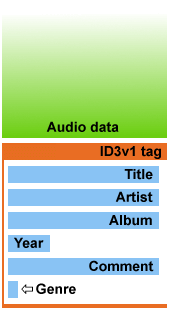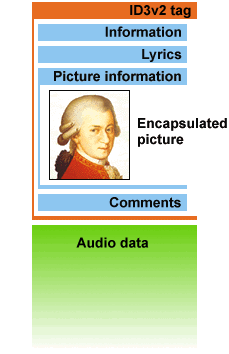什么是ID3
MP3是音频文件最流行的格式,它的全称是 MPEG layer III。但是这种格式不支持对于音频内容的描述信息,包括歌曲名称、演唱者、专辑等等。
因此在1996年,Eric Kemp在Studio 3项目中提出了ID3的解决方案。ID3全称是Identity of MP3,其解决方案是在音频文件末尾附加一串数据,包含关于歌曲的名称、歌手、图片的信息。为了方便检测,数据的长度固定为128bytes。这个版本的解决方案称为 ID3v1。
Michael Mutschler 在 1997 对格式进行了微小的调整,压缩了Comment字段,增加了Track信息,这个版本被称为ID3v1.1。
1998年,Martin Nilsson & Michael Mutschler牵头,多个贡献者一起发起了ID3v2的工作。这个班的结构和ID3v1完全不同,数据的长度不再固定,位置也从尾部移到了头部,并且引入了Unicode支持。ID3v2的第一个版本是ID3v2.2,2000年发布了ID3v2.4。
ID3v1
附着在音频数据之后,长度为128bytes,每个字段最大支持30个字符。

具体的字段信息
在数据开始之前,总是有三个字符TAG,这样和上面的字段加起来,正好是128bytes。如果Artist字段内容不足30个字符,不足的部分用0填充。
ID3v2
ID3v2是加在音频数据前面的一组数据,每项具体的数据称为frame(例如歌曲名称)。可以包含任意类型的数据,每个frame最大支持16MB,整个tag大小最大支持256MB。存储编码支持Unicode,这样就不会产生乱码问题。
Tag数据放在音频数据之前还有一个好处,对于流式访问可以首先获得歌曲信息并展现给用户。

列举一些特性:
- The ID3v2 tag is a container format, just like IFF or PNG files, allowing new frames (chunks) as evolution proceeds.
- Residing in the beginning of the audio file makes it suitable for streaming.
- Has an ‘unsynchronization scheme’ to prevent ID3v2-incompatible players to attempt to play the tag.
- Maximum tag size is 256 megabytes and maximum frame size is 16 megabytes.
- Byte conservative and with the capability to compress data it keeps the files small.
- The tag supports Unicode.
- Isn’t entirely focused on musical audio, but also other types of audio.
- Has several new text fields such as composer, conductor, media type, BPM, copyright message, etc. and the possibility to design your own as you see fit.
- Can contain lyrics as well as music-synced lyrics (karaoke) in almost any language.
- Is able to contain volume, balance, equalizer and reverb settings.
- Could be linked to CD-databases such as CDDB and FreeDB.
- Is able to contain images and just about any file you want to include.
- Supports enciphered information, linked information and weblinks.
使用 Python 读取ID3 信息
我写了一个 Python 脚本可以用来读取 ID3v1 的信息。实际操作过程中发现两个问题:
1、ID3v1的信息没有编码字段,所以有的时候同样的Mp3,在不同的系统环境中播放,会显示乱码。针对这个问题,打算再写一篇文章说一下如何探测编码。
2、iTunes应该是优先使用ID3v2的信息
我把脚本放到了 github 上,感兴趣的同学可以通过https://github.com/cocowool/py-id3查看。
1 | # Read ID3v1 tag information |
本文为作者原创,如果您觉得本文对您有帮助,请随意打赏,您的支持将鼓励我继续创作。
参考资料:
1、ID3.org
2、Wiki ID3
3、Python open() 函数
4、使用Python读取和写入mp3文件的id3v1信息
5、Python 模块
